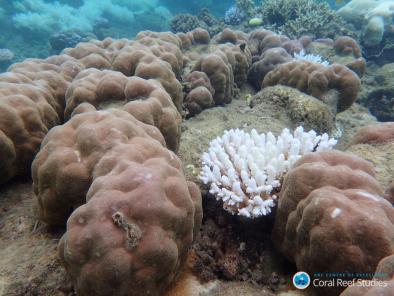Large Sections of Australia’s Great Reef Are Now Dead, Scientists Find

“We didn’t expect to see this level of destruction to the Great Barrier Reef for another 30 years,” said Terry P. Hughes, director of a government-funded center for coral reef studies at James Cook University in Australia and the lead author of a paper on the reef that is being published Thursday as the cover article of the journal Nature. “In the north, I saw hundreds of reefs — literally two-thirds of the reefs were dying and are now dead.”
...
With this latest global bleaching in its third year, reef scientists say they have no doubt as to the responsible party.
They warned decades ago that the coral reefs would be at risk if human society kept burning fossil fuels at a runaway pace, releasing greenhouse gases that warm the ocean. Emissions continued to rise, and now the background ocean temperature is high enough that any temporary spike poses a critical risk to reefs.
...
Corals require warm water to thrive, but they are exquisitely sensitive to extra heat. Just two or three degrees Fahrenheit of excess warming can sometimes kill the tiny creatures.
Globally, the ocean has warmed by about 1.5 degrees Fahrenheit since the late 19th century, by a conservative calculation, and a bit more in the tropics, home to many reefs. An additional kick was supplied by an El Niño weather pattern that peaked in 2016 and temporarily warmed much of the surface of the planet, causing the hottest year in a historical record dating to 1880.
It was obvious last year that the corals on many reefs were likely to die, but now formal scientific assessments are coming in. The paper in Nature documents vast coral bleaching in 2016 along a 500-mile section of the reef north of Cairns, a city on Australia’s eastern coast.
Bleaching indicates that corals are under heat stress, but they do not always die and cooler water can help them recover. Subsequent surveys of the Great Barrier Reef, conducted late last year after the deadline for inclusion in the Nature paper, documented that extensive patches of reef had in fact died, and would not be likely to recover soon, if at all.
Professor Hughes led those surveys. He said that he and his students cried when he showed them maps of the damage, which he had calculated in part by flying low in small planes and helicopters.
His aerial surveys, combined with underwater measurements, found that 67 percent of the corals had died in a long stretch north of Port Douglas, and in patches, the mortality reached 83 percent.
By luck, a storm stirred the waters in the central and southern parts of the reef at a critical moment, cooling them, and mortality there was much lower — about 6 percent in a stretch off Townsville, and even lower in the southernmost part of the reef.
But an Australian government study released last week found that over all, last year brought “the highest sea surface temperatures across the Great Barrier Reef on record.”
Related Content



